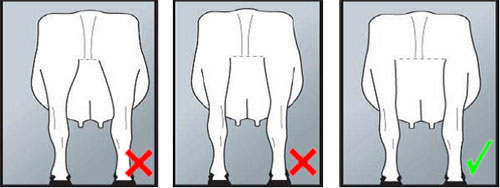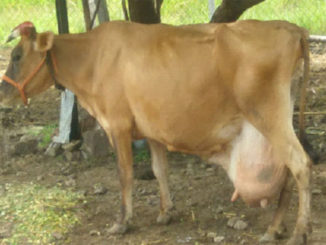Introduction
Conformation traits play a major role in dairy cow selection. Among them, udder and teat conformation is evaluated with utmost care. Factors like milk yield, long productive life, development of young calves and disease condition like mastitis mostly depend on the condition of udder. Therefore, conformation of udder and teat should not be undermined during dairy cow selection. This topic explains in detail about conformation traits related with udder and teat.
Fore udder attachment
Fore udder should be strongly and firmly attached to the lower line of the abdominal wall. Loose attachment of udder to the abdominal increases the chance of mastitis in dairy cattle. Firm attachment of the fore udder can be identified by absence of wrinkles at the site of attachment.

Rear udder width
Width of rear udder should be wide and uniform from top (at point of attachment) to bottom.

Udder depth
The depth of the udder should not be too deep or too shallow. The optimum udder depth is when the lower part of udder is at level of hock (hind knee). If the lower part of udder is below the level of hock it increases the susceptibility to mastitis and if it is above the level of hock milk yield of the animal will be low. At the same time, depth of udder depends on the age of the cow. In general heifers have shallow udder and older cows have deep udder.

Cleft of udder (Central ligament)
A deep udder cleft indicates strong attachment of the udder. The cleft should be deep from top to bottom and divide the udder into two equal halves. The cleft is formed by a ligament that contributes to 60% of udder support.

Teat length
Teats should be cylindrical shape and of uniform size with medium length and diameter. With smaller teats, milking becomes difficult and new born calves also face difficulty during suckling. With lengthy teats, milk stays in teat even after full milking, therefore there are chances that animal may suffer from mastitis. Machine milking is also impossible with smaller teats. Therefore, medium sized teats with cylindrical shape should be preferred.

Teat placement
Teats should be squarely placed under each quarter and should be perpendicular to the ground level. The position of rear teat should not be outside or inside of quarters.

The criteria mentioned here for udder and teat traits will help the farmers to purchase animals with high milk yield, reduced susceptibility to mastitis and a long productive life.
Note: Pictures given in the article are taken from- ‘ICAR Guidelines for Conformation Recording of Dairy Cattle, Beef Cattle and Dairy Goats’.






1 Trackback / Pingback